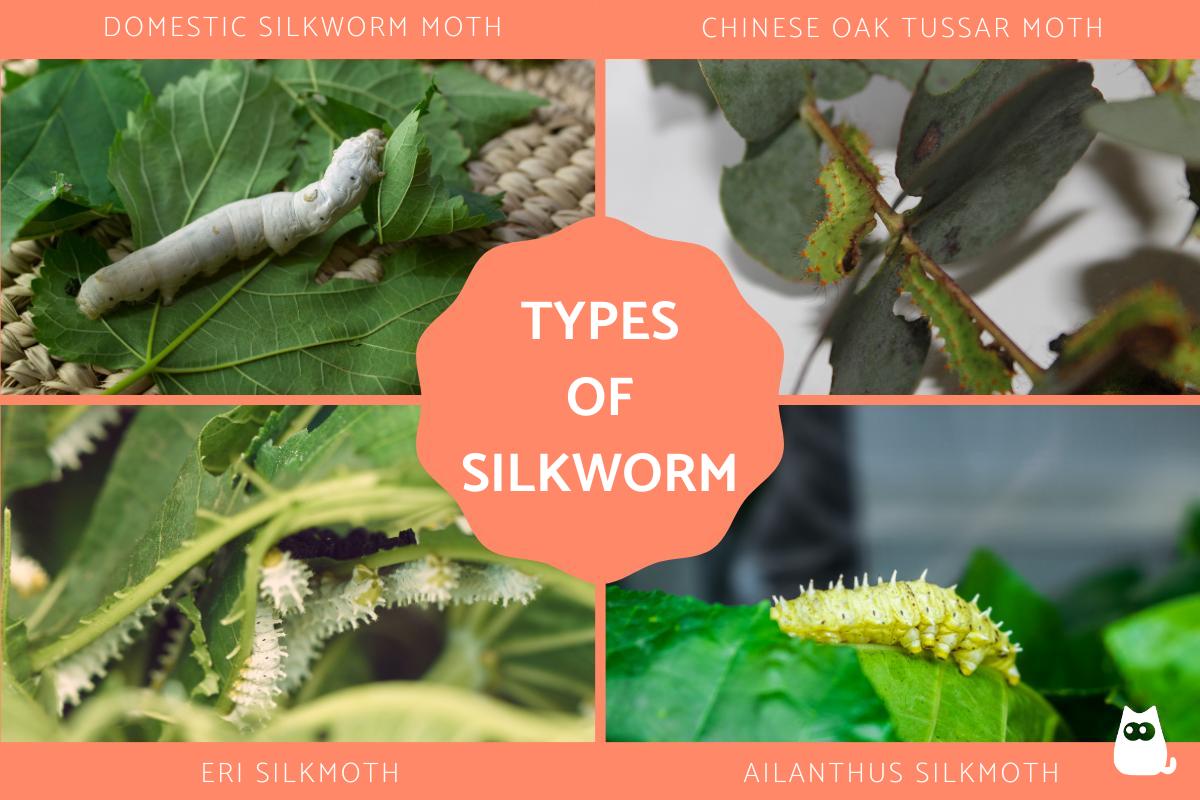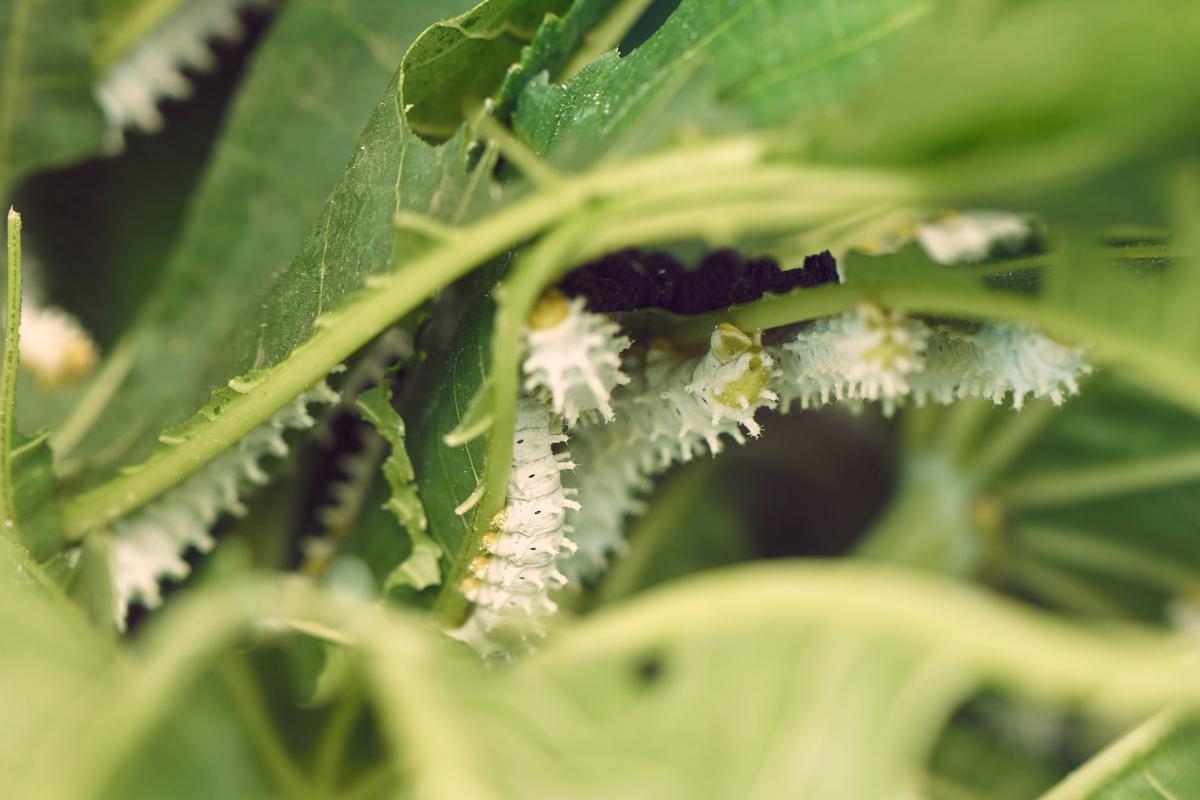Types of Silkworm - Breeds and Species


Silkworms belong to the order Lepidoptera, but it is important to know they are not actually worms. They are moths, but are most well known to us when they are in the larval stage. This is the stage during which they secrete proteins which harden into a filament that can be woven to form their pupae. It is this material that humans use to create silk fabric, although they also have other uses beyond the textile industry. As animals, they are fascinating in their own right. While all types of silkworm share certain characteristics, there are more than one breed. This is highlighted by the fact they adapt to various habitats around the world.
At AnimalWised, we discover more about the similarities and differences between the 8 types of silkworm breeds and species. We provide information on each one, as well as photos so you can see their differences more clearly.
- Domestic silkworm moth (Bombyx mori)
- Chinese oak tussar moth (Antheraea pernyi)
- Eri silkmoth (Samia ricini)
- Ailanthus silkmoth (Philosamia cynthia)
- Wild silkworm (Gonometa rufobrunnea)
- South India small tussore (Antheraea mylitta)
- Wild silkmoth (Bombyx mandarina)
- Promethea silkmoth (Callosamia promethea)
- Types of silkworm breeds
Domestic silkworm moth (Bombyx mori)
Known as the domestic silkworm moth, Bombyx mori is a species of lepidopteran native to Asia. They are especially common China, something which has played a key role in silk production throughout this country's history. It belongs to the Bombycidae family and its scientific name, ‘mori’ refers to the mulberry plant, whose leaves are its main source of food.
This type of silkworm undergoes a life cycle that includes the egg, larva (worm), pupa (cocoon) and adult (moth) stages. In its larval phase, it reaches a size of approximately 3-4" (7-10 cm) and has an initially white color that becomes more yellow as it develops. The larva feeds exclusively on mulberry leaves, consuming large quantities to produce enough silk for their cocoon.
Silk production is a distinctive characteristic of the domestic silkworm moth Bombyx mori. During its larval phase, the worm produces silk through specialized sericogenic glands in its head. These glands secrete a liquid that solidifies upon contact with air, forming silk threads. Before entering the pupal phase, the silkworm weaves a cocoon around itself using these silk threads, providing protection during its transformation.
Learn more about how silkworms and other animals transform with our guide to animals that go through metamorphosis.

Chinese oak tussar moth (Antheraea pernyi)
Also known as the Chinese tasar moth, this is a lepidopteran species adapted to temperate climates, being native to China and other Asian regions. The size of Antheraea pernyi reaches a length of 3-4" (8-10 cm) during its larval phase. Its larvae exhibit a notable variation in colors, ranging from green to brown tones. These provide camouflage in their natural environment.
This type of silkworm feeds on oak leaves, showing a distinct preference compared to Bombyx mori which feeds exclusively on mulberry. This adaptation to a different diet reflects its ability to thrive in temperate climates, where mulberry trees may not be as prevalent. They are used to create a specific type of silk, tussar silk which is commonly used to make sarees.
Antheraea pernyi has sparked interest not only for its silk production, but also for its adaptability to specific environments. Its presence in China and other parts of Asia makes it a fascinating component of the silkworm world, highlighting the biological and ecological diversity within this family of insects.

Eri silkmoth (Samia ricini)
The Samia ricini, known as the Eri silkmoth, is a lepidopteran species found primarily in North and South America. Standing out for its wingspan, which can reach up to 6" (15 cm), this silkworm moth shows notable adaptability and versatility in its habitat.
Its larva has a varied palette of colors, being recognized for its resistance to various climatic conditions and its ability to feed on a wide variety of plants. They have a particular preference for castor leaves. Although not as commercially exploited as Bombyx mori, Samia ricini has captured attention for both its impressive size and its ability to thrive in different environments. This is one of the biggest tpyes of silkworm.
The presence of Samia ricini in America contributes to the richness of the biological diversity of silkworms, highlighting their resilience and adaptation to a wide range of environmental conditions. Although its role in silk production is less prominent commercially, it is still of interest in scientific studies and in insect breeding due to its unique characteristics.

Ailanthus silkmoth (Philosamia cynthia)
The ailanthus silkworm moth is a species native to Asia that stands out for its ability to produce high-quality silk. In the adult stage, it has an impressive wingspan, reaching between 4-6" (10-15 cm) and its wings exhibit a varied color palette ranging from yellow and green to brown tones.
Also not as commercially exploited as Bombyx mori, this type of silkworm feeds primarily on the leaves of Ailanthus trees, although it may also consume other tree species. Their silk is considered to be of good quality, but its commercial use is limited compared to other silkworm species.
Learn more about how these insects transform from egg to adult stage with our article on the silkworm life cycle.

Wild silkworm (Gonometa rufobrunnea)
Gonometa rufobrunnea, known as the African silkworm moth or the wild silkworm, is a species that in its adult stage acquires a wingspan that can reach around 4" (10 cm). This moth presents a spectrum of varied colors on its wings, from brown to red and yellow tones, giving it a colorful and striking appearance. This species is found in various regions of Africa and its caterpillars feed on various plants, including the Guinea chestnut.
This type of silkworm is also popular for silk production, but not to the same commercial level as some more prominent species. Its silk has local applications and is used in some African communities for making traditional fabrics and crafts. Due to its cultural and economic importance in certain communities, the conservation of Gonometa rufobrunnea is crucial to guarantee its preservation and maintain ecological balance in its habitats.
South India small tussore (Antheraea mylitta)
Also known as the tasar silkworm moth, vanya silkworm moth or the South India small tussore, Antheraea mylitta is a species that plays a prominent role in silk production in some tropical regions of Asia. This silkworm has wings with a range of colors that range from brown and yellow to green tones, allowing for camouflage in tropical natural environments.
This species is found in deciduous forests, feeding on various species of trees such as those of the genera Terminalia, Shorea and Madhuca. Its life cycle follows the conventional stages of egg, larva, pupa and adult. Likewise, in the larval phase it stands out for the production of silk to weave pupa cocoons.
The silk produced by Antheraea mylitta is known as Tussar silk. Although not as fine as Bombyx mori silk, the silk of this worm is prized for its strength and rougher texture. It is used in textile production to create rustic fabrics and durable garments. On an economic level, this species contributes to the local textile industry in some tropical regions, so silkworm farming has deep roots in the cultural and traditional practices of these areas.

Wild silkmoth (Bombyx mandarina)
Also known as the mandarin silkworm or wild silkworm moth, this is the wild species from which the domestic silkworm moth (Bombyx mori) was derived. It is, therefore, also native to China. Of similar size to the domestic kind, this silkworm has a soft, segmented body.
Although it shares similarities with Bombyx mori in terms of life cycle, with egg, larva, pupa and adult stages, Bombyx mandarina is distinguished by its adaptation to the specific conditions of its natural environment in China.
The breeding of this species is carried out with the aim of obtaining its silk, which has local applications in China and other Asian regions. For example, this species is prized for its role in the sericulture tradition in China.

Promethea silkmoth (Callosamia promethea)
We finish the list of types of silkworm species with this very particular one. The Promethea moth is a species native to North America that has fascinating characteristics. Their wings display a distinctive pattern with shades of brown, gray and white.
Although Callosamia promethea produces silk to weave its pupal cocoon, this silk is not used commercially on a large scale. The quantity and quality of silk is limited compared to other more prominent silkworm species. The Promethea moth plays an important role in forest ecosystems, contributing to natural balance by interacting with plants and other organisms.

Types of silkworm breeds
While there may be variations in terms within each species, only the domestic silkworm moth (Bombyx mori) is known to have specific breeds. This is due to the domestication process of the wild species, with breeding for silk production largely contributing to the greater diversity of this species compared to other types of silkworms.
Some of the types of breeds of silkworm include:
- Chinese domestic silkworm moth
- Japanese domestic silkworm moth
- European domestic silkworm moth
- Hybrid domestic silkworm moth
The hybrid silkworm moth is like the mixed-breed version of this species. These different silkworm breeds may produce silk filaments which differ slightly in terms of texture, color, strength and other characteristics.
If you want to read similar articles to Types of Silkworm - Breeds and Species, we recommend you visit our Facts about the animal kingdom category.
- Andersson, M., Johansson, J., & Rising, A. (2016). Silk spinning in silkworms and spiders. International journal of molecular sciences, 17(8), 1290.
- Chen, F., Porter, D., & Vollrath, F. (2012). Morphology and structure of silkworm cocoons. Materials Science and Engineering: C, 32(4), 772-778.
- Chen, F., Porter, D., & Vollrath, F. (2012). Structure and physical properties of silkworm cocoons. Journal of the Royal Society Interface, 9(74), 2299-2308.
- Mondal, M., Trivedy, K., & Nirmal, K.S. (2007). The silk proteins, sericin and fibroin in silkworm, Bombyx mori Linn. - to review.
- Zhao, H. P., Feng, X. Q., Yu, S. W., Cui, W. Z., & Zou, F. Z. (2005). Mechanical properties of silkworm cocoons. Polymer, 46(21), 9192-9201.












